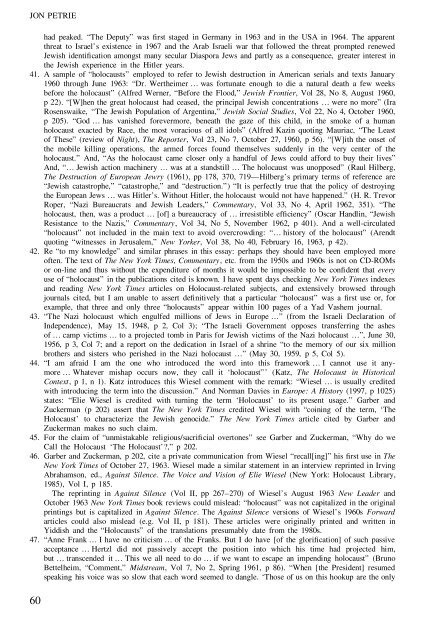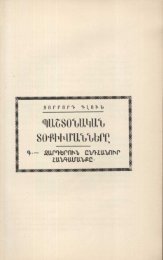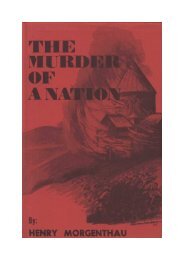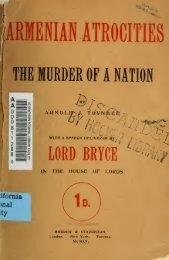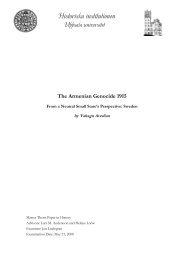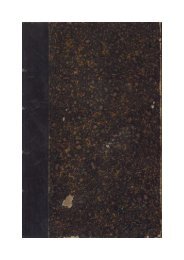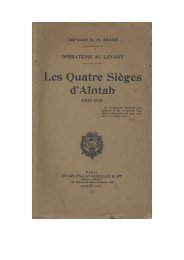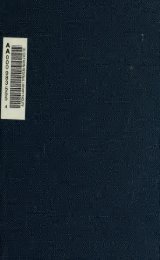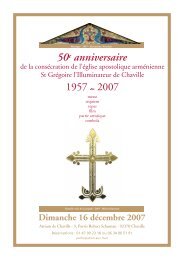The secular word HOLOCAUST: scholarly myths, history, and 20th ...
The secular word HOLOCAUST: scholarly myths, history, and 20th ...
The secular word HOLOCAUST: scholarly myths, history, and 20th ...
Create successful ePaper yourself
Turn your PDF publications into a flip-book with our unique Google optimized e-Paper software.
JON PETRIEhad peaked. “<strong>The</strong> Deputy” was rst staged in Germany in 1963 <strong>and</strong> in the USA in 1964. <strong>The</strong> apparentthreat to Israel’s existence in 1967 <strong>and</strong> the Arab Israeli war that followed the threat prompted renewedJewish identi cation amongst many <strong>secular</strong> Diaspora Jews <strong>and</strong> partly as a consequence, greater interest inthe Jewish experience in the Hitler years.41. A sample of “holocausts” employed to refer to Jewish destruction in American serials <strong>and</strong> texts January1960 through June 1963: “Dr. Wertheimer … was fortunate enough to die a natural death a few weeksbefore the holocaust” (Alfred Werner, “Before the Flood,” Jewish Frontier, Vol 28, No 8, August 1960,p 22). “[W]hen the great holocaust had ceased, the principal Jewish concentrations … were no more” (IraRosenswaike, “<strong>The</strong> Jewish Population of Argentina,” Jewish Social Studies, Vol 22, No 4, October 1960,p 205). “God … has vanished forevermore, beneath the gaze of this child, in the smoke of a humanholocaust exacted by Race, the most voracious of all idols” (Alfred Kazin quoting Mauriac, “<strong>The</strong> Leastof <strong>The</strong>se” (review of Night), <strong>The</strong> Reporter, Vol 23, No 7, October 27, 1960, p 56). “[W]ith the onset ofthe mobile killing operations, the armed forces found themselves suddenly in the very center of theholocaust.” And, “As the holocaust came closer only a h<strong>and</strong>ful of Jews could afford to buy their lives”And, “… Jewish action machinery … was at a st<strong>and</strong>still … <strong>The</strong> holocaust was unopposed” (Raul Hilberg,<strong>The</strong> Destruction of European Jewry (1961), pp 178, 370, 719—Hilberg’s primary terms of reference are“Jewish catastrophe,” “catastrophe,” <strong>and</strong> “destruction.”) “It is perfectly true that the policy of destroyingthe European Jews … was Hitler’s. Without Hitler, the holocaust would not have happened.” (H. R. TrevorRoper, “Nazi Bureaucrats <strong>and</strong> Jewish Leaders,” Commentary, Vol 33, No 4, April 1962, 351). “<strong>The</strong>holocaust, then, was a product … [of] a bureaucracy of … irresistible ef ciency” (Oscar H<strong>and</strong>lin, “JewishResistance to the Nazis,” Commentary, Vol 34, No 5, November 1962, p 401). And a well-circulated“holocaust” not included in the main text to avoid overcrowding: “… <strong>history</strong> of the holocaust” (Arendtquoting “witnesses in Jerusalem,” New Yorker, Vol 38, No 40, February 16, 1963, p 42).42. Re “to my knowledge” <strong>and</strong> similar phrases in this essay: perhaps they should have been employed moreoften. <strong>The</strong> text of <strong>The</strong> New York Times, Commentary, etc. from the 1950s <strong>and</strong> 1960s is not on CD-ROMsor on-line <strong>and</strong> thus without the expenditure of months it would be impossible to be con dent that everyuse of “holocaust” in the publications cited is known. I have spent days checking New York Times indexes<strong>and</strong> reading New York Times articles on Holocaust-related subjects, <strong>and</strong> extensively browsed throughjournals cited, but I am unable to assert de nitively that a particular “holocaust” was a rst use or, forexample, that three <strong>and</strong> only three “holocausts” appear within 100 pages of a Yad Vashem journal.43. “<strong>The</strong> Nazi holocaust which engulfed millions of Jews in Europe …” (from the Israeli Declaration ofIndependence), May 15, 1948, p 2, Col 3); “<strong>The</strong> Israeli Government opposes transferring the ashesof … camp victims … to a projected tomb in Paris for Jewish victims of the Nazi holocaust …”, June 30,1956, p 3, Col 7; <strong>and</strong> a report on the dedication in Israel of a shrine “to the memory of our six millionbrothers <strong>and</strong> sisters who perished in the Nazi holocaust …” (May 30, 1959, p 5, Col 5).44. “I am afraid I am the one who introduced the <strong>word</strong> into this framework … I cannot use it anymore… Whatever mishap occurs now, they call it ‘holocaust”’ (Katz, <strong>The</strong> Holocaust in HistoricalContext, p 1, n 1). Katz introduces this Wiesel comment with the remark: “Wiesel … is usually creditedwith introducing the term into the discussion.” And Norman Davies in Europe: A History (1997, p 1025)states: “Elie Wiesel is credited with turning the term ‘Holocaust’ to its present usage.” Garber <strong>and</strong>Zuckerman (p 202) assert that <strong>The</strong> New York Times credited Wiesel with “coining of the term, ‘<strong>The</strong>Holocaust’ to characterize the Jewish genocide.” <strong>The</strong> New York Times article cited by Garber <strong>and</strong>Zuckerman makes no such claim.45. For the claim of “unmistakable religious/sacri cial overtones” see Garber <strong>and</strong> Zuckerman, “Why do weCall the Holocaust ‘<strong>The</strong> Holocaust’?,” p 202.46. Garber <strong>and</strong> Zuckerman, p 202, cite a private communication from Wiesel “recall[ing]” his rst use in <strong>The</strong>New York Times of October 27, 1963. Wiesel made a similar statement in an interview reprinted in IrvingAbrahamson, ed., Against Silence. <strong>The</strong> Voice <strong>and</strong> Vision of Elie Wiesel (New York: Holocaust Library,1985), Vol I, p 185.<strong>The</strong> reprinting in Against Silence (Vol II, pp 267–270) of Wiesel’s August 1963 New Leader <strong>and</strong>October 1963 New York Times book reviews could mislead: “holocaust” was not capitalized in the originalprintings but is capitalized in Against Silence. <strong>The</strong> Against Silence versions of Wiesel’s 1960s Forwardarticles could also mislead (e.g. Vol II, p 181). <strong>The</strong>se articles were originally printed <strong>and</strong> written inYiddish <strong>and</strong> the “Holocausts” of the translations presumably date from the 1980s.47. “Anne Frank … I have no criticism … of the Franks. But I do have [of the glori cation] of such passiveacceptance … Hertzl did not passively accept the position into which his time had projected him,but … transcended it … This we all need to do … if we want to escape an impending holocaust” (BrunoBettelheim, “Comment,” Midstream, Vol 7, No 2, Spring 1961, p 86). “When [the President] resumedspeaking his voice was so slow that each <strong>word</strong> seemed to dangle. ‘Those of us on this hookup are the only60


